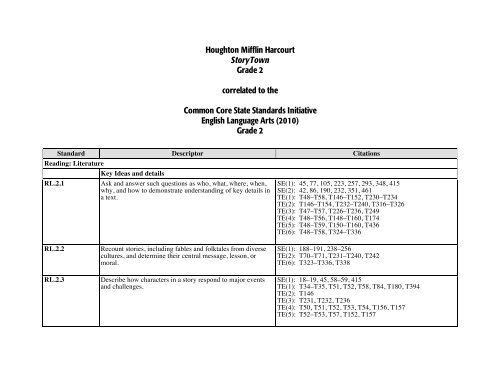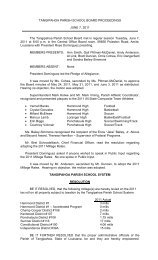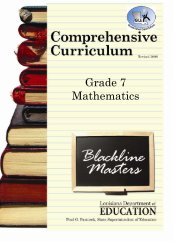Houghton Mifflin Harcourt StoryTown Grade 2 correlated to the ...
Houghton Mifflin Harcourt StoryTown Grade 2 correlated to the ...
Houghton Mifflin Harcourt StoryTown Grade 2 correlated to the ...
You also want an ePaper? Increase the reach of your titles
YUMPU automatically turns print PDFs into web optimized ePapers that Google loves.
<strong>Hough<strong>to</strong>n</strong> <strong>Mifflin</strong> <strong>Harcourt</strong> <strong>S<strong>to</strong>ryTown</strong> <strong>correlated</strong> <strong>to</strong> <strong>the</strong>Common Core State Standards Initiative for English Language Arts (2010), <strong>Grade</strong> 2RL.2.4Standard Descrip<strong>to</strong>r CitationsCraft and StructureDescribe how words and phrases (e.g., regular beats,alliteration, rhymes, repeated lines) supply rhythm andmeaning in a s<strong>to</strong>ry, poem, or song.TE(2): T161, T247, T316TE(4): T149, T154, T256, T333RL.2.5RL.2.6Describe <strong>the</strong> overall structure of a s<strong>to</strong>ry, including describinghow <strong>the</strong> beginning introduces <strong>the</strong> s<strong>to</strong>ry and <strong>the</strong> endingconcludes <strong>the</strong> action.Acknowledge differences in <strong>the</strong> points of view of characters,including by speaking in a different voice for each characterwhen reading dialogue aloud.SE(1): 266–267TE(1): T36TE(2): T218–T219, T232–T235, T238–T240, T252, T266,T302, T304, T338, T354, T364, T416, T437TE(4): T50, T51, T52, T85, T146TE(5): T397TE(6): T86SE(1): 51, 263, 301SE(2): 47, 197, 237TE(1): T73TE(2): T255, T275, T343TE(4): T73TE(5): T75, T177RL.2.7RL.2.8Integration of Knowledge and IdeasUse information gained from <strong>the</strong> illustrations and words in aprint or digital text <strong>to</strong> demonstrate understanding of itscharacters, setting, or plot.(Not applicable <strong>to</strong> literature)SE(1): 45, 77SE(2): 18–19, 54–55, 162–163, 204–205TE(1): T47–T58, T146–T152, T230–T234TE(2): T233TE(3): T53TE(4): T34, T36, T49, T51, T67, T83, T84, T85, T95, T134,T148, T171, T174, T187, T197, T389, T406TE(5): T34, T49, T51, T53, T57, T59, T60, T69, T85, T87,T97, T136, T152, T158, T171, T187, T197, T397,T414, T436TE(6): T862
<strong>Hough<strong>to</strong>n</strong> <strong>Mifflin</strong> <strong>Harcourt</strong> <strong>S<strong>to</strong>ryTown</strong> <strong>correlated</strong> <strong>to</strong> <strong>the</strong>Common Core State Standards Initiative for English Language Arts (2010), <strong>Grade</strong> 2RL.2.9Standard Descrip<strong>to</strong>r CitationsCompare and contrast two or more versions of <strong>the</strong> same s<strong>to</strong>ry(e.g., Cinderella s<strong>to</strong>ries) by different authors or from differentcultures.This standard will be covered in our new <strong>S<strong>to</strong>ryTown</strong> CommonCore Bonus (available in 2011).RL.2.10Range of reading and Level of text ComplexityBy <strong>the</strong> end of <strong>the</strong> year, read and comprehend literature,including s<strong>to</strong>ries and poetry, in <strong>the</strong> grades 2–3 text complexityband proficiently, with scaffolding as needed at <strong>the</strong> high endof <strong>the</strong> range.SE(1): 22–44, 64–76, 94–104, 108–109, 188–191, 204–222,238–256, 260–261, 270–292, 328–347, 392–414, 418–419SE(2): 22–41, 58–85, 88–89, 166–189, 208–231, 322–336,424–425, 434–460TE(1): T47–T58, T145–T152, T229–T234, T247TE(2): T70–T71, T145–T154, T231–T240, T253, T315–T326TE(3): T47–T56, T225–T236, T249TE(4): T47–T56, T148–T160, T174TE(5): T47–T58, T148–T160, T436TE(6): T47–T58, T256–T257, T322–T3363
<strong>Hough<strong>to</strong>n</strong> <strong>Mifflin</strong> <strong>Harcourt</strong> <strong>S<strong>to</strong>ryTown</strong> <strong>correlated</strong> <strong>to</strong> <strong>the</strong>Common Core State Standards Initiative for English Language Arts (2010), <strong>Grade</strong> 2Standard Descrip<strong>to</strong>r CitationsReading: Informational TextRI.2.1Key Ideas and detailsAsk and answer such questions as who, what, where, when,why, and how <strong>to</strong> demonstrate understanding of key details ina text.SE(1): 134, 381, 444SE(2): 110, 135, 272, 296, 384, 422TE(1): T165–T167, T309–T316TE(2): T169, T341TE(3): T143–T151, T312–T319TE(4): T238–T240, T322–T327TE(5): T238–T246, T249–T251, T330–T334TE(6): T70, T150, T152–T157, T235–T245RI.2.2Identify <strong>the</strong> main <strong>to</strong>pic of a multiparagraph text as well as <strong>the</strong>focus of specific paragraphs within <strong>the</strong> text.TE(3): T149TE(4): T270TE(5): T236, T252, T262, T331, T332TE(6): T238RI.2.3Describe <strong>the</strong> connection between a series of his<strong>to</strong>rical events,scientific ideas or concepts, or steps in technical procedures ina text.TE(1): T165–T167, T329TE(3): T145, T146, T148, T149M T150, T314RI.2.4RI.2.5Craft and StructureDetermine <strong>the</strong> meaning of words and phrases in a textrelevant <strong>to</strong> a grade 2 <strong>to</strong>pic or subject area.Know and use various text features (e.g., captions, bold print,subheadings, glossaries, indexes, electronic menus, icons) <strong>to</strong>locate key facts or information in a text efficiently.SE(2): 96–97, 120–121, 242–243, 282–283TE(4): T234–T235, T241, T242, T318–T319TE(5): T234–T235, T326–T327TE(6): T242SE(2): 110, 154–157TE(4): T224–T225, T241, T243, T244, T253, T269, T281,T308–T309, T324, T327, T328, T337, T353, T363,T416, T4374
<strong>Hough<strong>to</strong>n</strong> <strong>Mifflin</strong> <strong>Harcourt</strong> <strong>S<strong>to</strong>ryTown</strong> <strong>correlated</strong> <strong>to</strong> <strong>the</strong>Common Core State Standards Initiative for English Language Arts (2010), <strong>Grade</strong> 2RI.2.6Standard Descrip<strong>to</strong>r CitationsIdentify <strong>the</strong> main purpose of a text, including what <strong>the</strong> authorwants <strong>to</strong> answer, explain, or describe.SE(1): 360–361, 381SE(2): 46, 246, 384TE(3): T130–T131, T145, T151, T152, T162, T176, T186,T379, T416TE(4): T72, T327TE(5): T238, T278, T333TE(6): T155, T157, T242RI.2.7RI.2.8RI.2.9RI.2.10Integration of Knowledge and IdeasExplain how specific images (e.g., a diagram showing how amachine works) contribute <strong>to</strong> and clarify a text.Describe how reasons support specific points <strong>the</strong> authormakes in a text.Compare and contrast <strong>the</strong> most important points presented bytwo texts on <strong>the</strong> same <strong>to</strong>pic.Range of reading and Level of textBy <strong>the</strong> end of year, read and comprehend informational texts,including his<strong>to</strong>ry/social studies, science, and technical texts,in <strong>the</strong> grades 2–3 text complexity band proficiently, withscaffolding as needed at <strong>the</strong> high end of <strong>the</strong> range.SE(2): 280–281, 296TE(5): T224–T225, T239, T240, T250–T251, T252, T261,T277, T289, T316, T330, T334–T335, T336, T361,T371, T424TE(6): T70, T168–T169, T272TE(1): T296–T297, T316, T352TE(4): T270SE(1): 138, 384SE(2): 279, 300, 390TE(1): T331TE(3): T165TE(5): T265, T349TE(6): T171SE(1): 80–85, 118–133, 226–229, 296–299, 364–380, 382–383, 428–443, 460–463SE(2): 44–45, 98–109, 122–134, 136–137, 192–195, 244–271,274–275, 284–295, 298–299, 354–355, 368–383, 386–389, 398–421, 464–465, 482–485TE(1): T165–T167, T309–T316, T356TE(2): T168–T169, T340–T341TE(3): T143–T151, T163, T311–T318, T415–T416TE(4): T237–T242, T321–T327TE(5): T72–T73, T236–T250, T262, T328–T334, T347TE(6): T71, T149–T156, T168–T169, T233–T244, T348,T436–T4385
<strong>Hough<strong>to</strong>n</strong> <strong>Mifflin</strong> <strong>Harcourt</strong> <strong>S<strong>to</strong>ryTown</strong> <strong>correlated</strong> <strong>to</strong> <strong>the</strong>Common Core State Standards Initiative for English Language Arts (2010), <strong>Grade</strong> 2Standard Descrip<strong>to</strong>r CitationsReading Standards: Foundational SkillsRF.2.3RF.2.3aPhonics and Word recognitionKnow and apply grade-level phonics and word analysis skills in decoding words.Distinguish long and short vowels when reading regularlyspelled one-syllable words.SE(1): 90–91TE(1): T30–T31, T32, T42–T43, T66–T67, T81, T128–T130,T140–T141, T160–T161, T177, T212–T214, T224–T225, T242–T243, T257, T292–T294, T304–T305,T374–T375, T392–T393, T402–T403RF.2.3bKnow spelling-sound correspondences for additional commonvowel teams.TE(1): T292–T293, T294–T295, T304–T305, T324–T325,T339, T349, T412–T413TE(2): T30–T32, T128–T130, T140–T141, T162–T163, T179,T189, T298–T300, T310–T311, T334–T335, T351,T361, T404–T405, T424–T425TE(4): T130–T132, T142–T143, T168–T169, T185, T195,T220–T222, T232–T233, T250–T251, T267, T279,T404–T405TE(5): T30–T32, T220–T222, T232–T233, T258–T259, T275,T287, T422–T423TE(6): T30–T31, T32–T33, T42–T43, T66–T67, T83, T95,T306–T307, T308–T309, T318–T319, T344–T345,T361, T371, T396–T397, T434–T435RF.2.3cDecode regularly spelled two-syllable words with longvowels.TE(1): T256, T266TE(2): T178, T188, T350, T360RF.2.3d Decode words with common prefixes and suffixes. TE(4): T80, T92, T266, T278TE(5): T274, T286TE(6): T82, T94, T268, T2806
<strong>Hough<strong>to</strong>n</strong> <strong>Mifflin</strong> <strong>Harcourt</strong> <strong>S<strong>to</strong>ryTown</strong> <strong>correlated</strong> <strong>to</strong> <strong>the</strong>Common Core State Standards Initiative for English Language Arts (2010), <strong>Grade</strong> 2RF.2.3eStandard Descrip<strong>to</strong>r CitationsIdentify words with inconsistent but common spelling-soundcorrespondences.SE(2): 394–395TE(2): T30–T31, T32–T33, T42–T43, T64–T65, T81, T91,T386–T387TE(4): T30–T31, T32–T33, T42–T43, T132, T386–T387TE(5): T222TE(6): T30–T32, T132–T134, T144–T145, T164–T165, T181,T191, T216–T217, T218–T219, T228–T229, T252–T253, T269, T281, T308, T424RF.2.3fRecognize and read grade-appropriate irregularly spelledwords.SE(2): 394–395TE(1): T33, T41, T42, T65, T67, T68, T79, T81, T89, T91,T127, T131, T139, T159, T161, T175, T177, T185,T211, T215, T223, T241, T255, T257, T265, T291,T295, T303, T304, T323, T325, T326, T337, T339,T347, T373, T391, T401, T411, T423TE(2): T33, T41, T42, T63, T65, T79, T81, T89, T127, T131,T139, T140, T161, T163, T177, T187, T213, T217,T225, T226, T247, T249, T261, T263, T271, T273,T297, T301, T309, T310, T312–T313, T333, T335,T349, T351, T359, T385, T403, T413, T423, T435TE(3): T33, T41, T42, T63, T65, T77, T79, T87, T89, T125,T129, T137, T138, T157, T159, T171, T173, T181,T207, T211, T219, T220, T243, T245, T246, T247,T259, T267, T293, T297, T305, T306, T325, T327,T339, T349, T375, T391, T401, T411, T423TE(4): T33, T41, T42, T63, T65, T79, T81, T91, T129, T133,T141, T142, T167, T169, T183, T185, T193, T195,T219, T223, T231, T232, T249, T251, T265, T267,T277, T303, T307, T315, T316, T333, T349, T351,T359, T385, T403, T413, T423, T435TE(5): T33, T41, T42, T65, T67, T81, T83, T93, T95, T131,T135, T143, T144, T167, T169, T183, T185, T193,T195, T219, T223, T231, T232, T257, T259, T273,T275, T285, T311, T315, T323, T341, T343, T357,T367, T393, T411, T421, T431, T4437
<strong>Hough<strong>to</strong>n</strong> <strong>Mifflin</strong> <strong>Harcourt</strong> <strong>S<strong>to</strong>ryTown</strong> <strong>correlated</strong> <strong>to</strong> <strong>the</strong>Common Core State Standards Initiative for English Language Arts (2010), <strong>Grade</strong> 2Standard Descrip<strong>to</strong>r CitationsRF.2.3fContinuedRF.2.4FluencyRead with sufficient accuracy and fluency <strong>to</strong> support comprehension.TE(6): T41, T65, T81, T83, T93, T95, T131, T135, T143,T144, T163, T165, T179, T181, T189, T191, T215,T216–T217, T219, T227, T228, T251, T253, T267,T269, T279, T281, T305, T309, T317, T318, T343,T345, T359, T369, T361, T371, T395, T413, T423,T433, T445RF.2.4a Read on-level text with purpose and understanding. TE(1): T47, T50, T71, T145, T163, T165, T229, T309, T329TE(2): T47, T145, T231, T280–T282, T315, T341TE(3): T47, T67, T143, T147, T225, T249, T276–T279, T311TE(4): T47, T147, T256, T286–T289, T321, T336, T340,T392, T445TE(5): T47, T72, T149, T156, T170, T237, T260, T329, T400,T453TE(6): T47, T70, T149, T168, T233, T256, T348, T402, T436,T455RF.2.4bRF.2.4cRead on-level text orally with accuracy, appropriate rate, andexpression on successive readings.Use context <strong>to</strong> confirm or self-correct word recognition andunderstanding, rereading as necessary.TE(1): T60, T163TE(2): T242, T251, T265, T275TE(3): T67, T329, T343TE(4): T66TE(5): T170, T260, T344, T370TE(6): T96, T254, T346, T362, T372TE(1): T163TE(3): T416TE(4): T46, T74–T75, T144, T146, T234, T318TE(5): T44, T146, T234, T326TE(6): T44, T146, T230, T3208
<strong>Hough<strong>to</strong>n</strong> <strong>Mifflin</strong> <strong>Harcourt</strong> <strong>S<strong>to</strong>ryTown</strong> <strong>correlated</strong> <strong>to</strong> <strong>the</strong>Common Core State Standards Initiative for English Language Arts (2010), <strong>Grade</strong> 2Standard Descrip<strong>to</strong>r CitationsWriting StandardsW.2.1Text Types and PurposesWrite opinion pieces in which <strong>the</strong>y introduce <strong>the</strong> <strong>to</strong>pic orbook <strong>the</strong>y are writing about, state an opinion, supply reasonsthat support <strong>the</strong> opinion, use linking words (e.g., because,and, also) <strong>to</strong> connect opinion and reasons, and provide aconcluding statement or section.TE(6): T225, T249, T277, T287W.2.2Write informative/explana<strong>to</strong>ry texts in which <strong>the</strong>y introduce a<strong>to</strong>pic, use facts and definitions <strong>to</strong> develop points, and providea concluding statement or section.SE(1): 87, 111, 231, 385SE(2): 91, 427TE(1): T77, T169, T249, T289, T335TE(2): T125, T171, T175TE(3): T123, T165, T169, T291, T337TE(4): T27, T77, T177, T181, T191TE(5): T117, T217, T271, T309, T355TE(6): T108–T115, T129, T177, T259W.2.3Write narratives in which <strong>the</strong>y recount a well-elaborated even<strong>to</strong>r short sequence of events, include details <strong>to</strong> describeactions, thoughts, and feelings, use temporal words <strong>to</strong> signalevent order, and provide a sense of closure.SE(1): 193, 263, 353SE(2): 139, 197, 237, 467TE(1): T104–T111,T113TE(2): T73, T211, T255, T259TE(3): T27, T71, T75, T255TE(4): T111, T115, T343, T347TE(5): T27, T39, T63, T75, T79, T91, T101, T177, T181TE(6): T351, T357W.2.4 (Begins in grade 3)Production and Distribution of Writing9
<strong>Hough<strong>to</strong>n</strong> <strong>Mifflin</strong> <strong>Harcourt</strong> <strong>S<strong>to</strong>ryTown</strong> <strong>correlated</strong> <strong>to</strong> <strong>the</strong>Common Core State Standards Initiative for English Language Arts (2010), <strong>Grade</strong> 2W.2.5Standard Descrip<strong>to</strong>r CitationsWith guidance and support from adults and peers, focus on a<strong>to</strong>pic and streng<strong>the</strong>n writing as needed by revising andediting.TE(1): T87, T97, T108–T110, T183, T193, T263, T345, T355,T389, T399TE(2): T87, T97, T110, T185, T269, T279, T357, T367, T401,T411TE(3): T85, T95, T107, T108, T179, T189, T265, T275, T347,T357, T389, T399TE(4): T89, T99, T112, T177, T191, T201, T275, T285, T357,T367, T401, T411TE(5): T91, T101, T110, T114, T191, T201, T283, T293,T365, T375, T409, T419TE(6): T91, T101, T112, T114, T187, T197, T277, T287,T367, T377, T411, T421W.2.6With guidance and support from adults, use a variety ofdigital <strong>to</strong>ols <strong>to</strong> produce and publish writing, including incollaboration with peers.TE(2): T111TE(3): T109TE(5): T115W.2.7Research <strong>to</strong> Build and Present KnowledgeParticipate in shared research and writing projects (e.g., read anumber of books on a single <strong>to</strong>pic <strong>to</strong> produce a report; recordscience observations).TE(1): T12TE(4): T36W.2.8Recall information from experiences or ga<strong>the</strong>r informationfrom provided sources <strong>to</strong> answer a question.TE(6): T112, T141, T161W.2.9 (Begins in grade 4)Range of WritingW.2.10 (Begins in grade 3)10
<strong>Hough<strong>to</strong>n</strong> <strong>Mifflin</strong> <strong>Harcourt</strong> <strong>S<strong>to</strong>ryTown</strong> <strong>correlated</strong> <strong>to</strong> <strong>the</strong>Common Core State Standards Initiative for English Language Arts (2010), <strong>Grade</strong> 2Standard Descrip<strong>to</strong>r CitationsSpeaking and Listening StandardsSL.2.1SL.2.1aComprehension and CollaborationParticipate in collaborative conversations with diverse partners about grade 2 <strong>to</strong>pics and texts with peers and adults in smalland larger groups.Follow agreed-upon rules for discussions (e.g., gaining <strong>the</strong>floor in respectful ways, listening <strong>to</strong> o<strong>the</strong>rs with care,speaking one at a time about <strong>the</strong> <strong>to</strong>pics and texts underdiscussion).TE(1): T13TE(2): T13TE(3): T13, T427TE(4): T13TE(5): T13TE(6): T13SL.2.1bSL.2.1cSL.2.2SL.2.3Build on o<strong>the</strong>rs’ talk in conversations by linking <strong>the</strong>ircomments <strong>to</strong> <strong>the</strong> remarks of o<strong>the</strong>rs.Ask for clarification and fur<strong>the</strong>r explanation as needed about<strong>the</strong> <strong>to</strong>pics and texts under discussion.Recount or describe key ideas or details from a text readaloud or information presented orally or through o<strong>the</strong>r media.Ask and answer questions about what a speaker says in order<strong>to</strong> clarify comprehension, ga<strong>the</strong>r additional information, ordeepen understanding of a <strong>to</strong>pic or issue.TE(2): T13TE(5): T13TE(6): T13TE(1): T13TE(2): T13, T441TE(3): T13TE(4): T13TE(5): T13TE(1): T36TE(3): T13TE(4): T13TE(5): T36TE(1): T13TE(2): T13TE(3): T13TE(4): T13TE(5): T1311
<strong>Hough<strong>to</strong>n</strong> <strong>Mifflin</strong> <strong>Harcourt</strong> <strong>S<strong>to</strong>ryTown</strong> <strong>correlated</strong> <strong>to</strong> <strong>the</strong>Common Core State Standards Initiative for English Language Arts (2010), <strong>Grade</strong> 2SL.2.4Standard Descrip<strong>to</strong>r CitationsPresentation of Knowledge and IdeasTell a s<strong>to</strong>ry or recount an experience with appropriate factsand relevant, descriptive details, speaking audibly in coherentsentences.TE(1): T39SL.2.5SL.2.6Create audio recordings of s<strong>to</strong>ries or poems; add drawings oro<strong>the</strong>r visual displays <strong>to</strong> s<strong>to</strong>ries or recounts of experienceswhen appropriate <strong>to</strong> clarify ideas, thoughts, and feelings.Produce complete sentences when appropriate <strong>to</strong> task andsituation in order <strong>to</strong> provide requested detail or clarification.(See grade 2 Language standards 1 and 3 on pages 26 and 27for specific expectations.)TE(1): T111TE(1): T39Language StandardsL.2.1Conventions of Standard EnglishDemonstrate command of <strong>the</strong> conventions of standard English grammar and usage when writing or speaking.L.2.1a Use collective nouns (e.g., group). This standard will be covered in our new <strong>S<strong>to</strong>ryTown</strong> CommonCore Bonus (available in 2011).L.2.1bForm and use frequently occurring irregular plural nouns(e.g., feet, children, teeth, mice, fish).TE(2): T174, T184, T194, T410, T440L.2.1c Use reflexive pronouns (e.g., myself, ourselves). This standard will be covered in our new <strong>S<strong>to</strong>ryTown</strong> CommonCore Bonus (available in 2011).L.2.1dL.2.1eForm and use <strong>the</strong> past tense of frequently occurring irregularverbs (e.g., sat, hid, <strong>to</strong>ld).Use adjectives and adverbs, and choose between <strong>the</strong>mdepending on what is <strong>to</strong> be modified.TE(6): T38, T62, T78, T90, T100, T140, T160, T174, T184,T186, T194, T196, T410, T420, T450TE(4): T38, T60, T76, T88, T98, T138, T164, T180, T190,T200, T228, T246, T346, T356, T366, T400, T410,T44012
<strong>Hough<strong>to</strong>n</strong> <strong>Mifflin</strong> <strong>Harcourt</strong> <strong>S<strong>to</strong>ryTown</strong> <strong>correlated</strong> <strong>to</strong> <strong>the</strong>Common Core State Standards Initiative for English Language Arts (2010), <strong>Grade</strong> 2L.2.1fL.2.2Standard Descrip<strong>to</strong>r CitationsProduce, expand, and rearrange complete simple andcompound sentences (e.g., The boy watched <strong>the</strong> movie; Thelittle boy watched <strong>the</strong> movie; The action movie was watchedby <strong>the</strong> little boy).TE(1): T38, T62, T76, T86, T96, T344, T388, T428TE(4): T38, T76, T180, T200Demonstrate command of <strong>the</strong> conventions of standard English capitalization, punctuation, and spelling when writing.L.2.2a Capitalize holidays, product names, and geographic names. TE(2): T244, T268, T278, T346, T356, T366, T420, T432,T440L.2.2b Use commas in greetings and closings of letters. TE(3): T103, T107, T109TE(6): T39, T91L.2.2cUse an apostrophe <strong>to</strong> form contractions and frequentlyoccurring possessives.TE(3): T134, T154, T168, T178, T179, T188, T216, T240,T254, T264, T274, T398, T408, T428TE(6): T314, T340, T356, T366, T376, T442, T450L.2.2dGeneralize learned spelling patterns when writing words (e.g.,cage → badge; boy → boil).TE(1): T67, T161, T243, T325, T403TE(2): T65, T163, T249, T335, T415TE(3): T65, T159, T245, T327, T403TE(4): T65, T169, T251, T335, T415TE(5): T67, T169, T259, T343, T423TE(6): T67, T165, T253, T345, T425L.2.2eConsult reference materials, including beginning dictionaries,as needed <strong>to</strong> check and correct spellings.This standard will be covered in our new <strong>S<strong>to</strong>ryTown</strong> CommonCore Bonus (available in 2011).L.2.3Knowledge of LanguageUse knowledge of language and its conventions when writing, speaking, reading, or listening.L.2.3a Compare formal and informal uses of English. This standard will be covered in our new <strong>S<strong>to</strong>ryTown</strong> CommonCore Bonus (available in 2011).13
<strong>Hough<strong>to</strong>n</strong> <strong>Mifflin</strong> <strong>Harcourt</strong> <strong>S<strong>to</strong>ryTown</strong> <strong>correlated</strong> <strong>to</strong> <strong>the</strong>Common Core State Standards Initiative for English Language Arts (2010), <strong>Grade</strong> 2L.2.4eStandard Descrip<strong>to</strong>r CitationsUse glossaries and beginning dictionaries, both print anddigital, <strong>to</strong> determine or clarify <strong>the</strong> meaning of words andphrases.TE(2): R18–R20TE(4): T355, T18–R21L.2.5L.2.5aDemonstrate understanding of word relationships and nuances in word meanings.Identify real-life connections between words and <strong>the</strong>ir use(e.g., describe foods that are spicy or juicy).TE(1): T37, T61, T74–T75, T85, T135, T155, T170–T171,T181, T219, T237, T250–T251, T261, T299, T319,T332–T333, T343, T387, T397, T419TE(2): T37, T59, T74–T75, T85, T135, T157, T172–T173,T183, T221, T243, T256–T257, T305, T318, T320,T329, T344–T345, T355, T399, T409, T419, T431TE(3): T37, T59, T72–T73, T83, T133, T153, T166–T167,T177, T215, T239, T252–T253, T263, T301, T321,T334–T335, T345, T387, T397, T407, T419TE(4): T37, T44, T59, T74–T75, T86, T96, T97, T137, T144,T163, T178–T179, T188–T189, T227, T234, T245,T260–T261, T272–T273, T283, T311, T318, T344–T345, T354–T355, T365, T399, T409, T419, T431TE(5): T37, T44, T61, T76–T77, T88, T99, T139, T146, T163,T178–T179, T188, T227, T234, T253, T266, T280,T319, T326, T337, T350–T351, T362, T372, T373,T407, T417, T427, T439TE(6): T37, T44, T61, T74–T75, T88, T99, T139, T146, T159,T172–T173, T184, T194, T223, T247, T260, T274,T285, T313, T320, T339, T352–T353, T364, T375,T409, T419, T429, T441L.2.5bL.2.6Distinguish shades of meaning among closely related verbs(e.g., <strong>to</strong>ss, throw, hurl) and closely related adjectives (e.g.,thin, slender, skinny, scrawny).Use words and phrases acquired through conversations,reading and being read <strong>to</strong>, and responding <strong>to</strong> texts, includingusing adjectives and adverbs <strong>to</strong> describe (e.g., When o<strong>the</strong>rkids are happy that makes me happy).TE(1): T353TE(5): T89, T189, T268–T269, T352–T353, T363, T365, T375TE(1): T36–T37, T221, T239, T253, T263, T273TE(4): T44–T45, T59, T139, T149, T151, T165, T181, T191,T201TE(6): T172–T173, T184, T23415
















